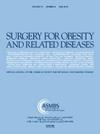Metabolic disease remission after Roux-en-Y gastric bypass depends on preoperative disease severity: use of a new objective metabolic scoring system
IF 3.5
3区 医学
Q1 SURGERY
引用次数: 0
Abstract
Background
Severity stratification and longitudinal evaluation of metabolic conditions in response to Roux-en-Y gastric bypass (RYGB) are not standardized. Our Assessment of Obesity-related Metabolic Comorbidities (AOMC) scoring tool combines pharmacotherapy and biochemical data to objectively define type 2 diabetes (T2D), hypertension (HTN), and dyslipidemia (DYS) severity. We previously showed that AOMC more accurately describes disease severity than clinical history alone.
Objectives
We aimed to show that AOMC more precisely and reproducibly measures metabolic disease response to RYGB and preoperative disease severity influences remission rates.
Setting
University hospital, United States.
Methods
AOMC scores for T2D, DYS, and HTN were calculated preoperatively and postoperatively (1-, 2-, and 5-years) for patients who underwent RYGB over 14 years. Generalized linear mixed-effect models were used to evaluate AOMC score trends and remission over time.
Results
Of 351 patients, 214, 188, and 303, presented with any T2D, DYS, or HTN respectively. One-year remission rates were: T2D 57.1%, DYS 59.7%, and HTN 29.3%. Over 5 years post-RYGB, remission rates declined for T2D (P < .05) and DYS (P < .05) but remained steady for HTN (P > .05). Remission was associated with preoperative disease severity: those with premetabolic disease had the highest remission rates (i.e., 1-year: pre-T2D 81.4%, pre-DYS 91.4%, pre-HTN 53.5%, all P < .05), while those with most severe scores preoperatively (untreated/uncontrolled) had the lowest remission rates.
Conclusions
AOMC allows precise assessment of comorbidity severity and disease-specific postoperative quantification of comorbidity responses and remission rates. These findings can guide preoperative metabolic disease optimization and postoperative metabolic recovery expectations and standardize communication regarding comorbidity severity.
Roux-en-Y 胃旁路术后代谢性疾病的缓解取决于术前疾病的严重程度:使用新的客观代谢评分系统
对 Roux-en-Y 胃旁路术(RYGB)代谢状况的严重程度分层和纵向评估尚未标准化。我们的 "肥胖相关代谢合并症评估"(AOMC)评分工具结合了药物治疗和生化数据,可客观界定 2 型糖尿病(T2D)、高血压(HTN)和血脂异常(DYS)的严重程度。我们以前的研究表明,AOMC 比单纯的临床病史更能准确地描述疾病的严重程度。我们的目标是证明 AOMC 能够更准确、更可重复地测量代谢性疾病对 RYGB 的反应,以及术前疾病严重程度对缓解率的影响。美国大学医院。对14年来接受RYGB手术的患者进行术前和术后(1年、2年和5年)T2D、DYS和HTN的AOMC评分计算。采用广义线性混合效应模型评估AOMC评分趋势和随时间变化的缓解情况。在351名患者中,分别有214人、188人和303人患有T2D、DYS或高血压。一年缓解率分别为T2D缓解率为57.1%,DYS缓解率为59.7%,高血压缓解率为29.3%。RYGB术后5年,T2D(< .05)和DYS(< .05)的缓解率有所下降,但高血压(> .05)的缓解率保持稳定。缓解率与术前疾病严重程度有关:代谢前疾病患者的缓解率最高(即1年:T2D术前81.4%,DYS术前91.4%,HTN术前53.5%,均< .05),而术前评分最严重(未治疗/未控制)的患者缓解率最低。AOMC可以精确评估合并症的严重程度,并在术后量化合并症的反应和缓解率。这些发现可以指导术前代谢疾病优化和术后代谢恢复预期,并规范有关合并症严重程度的沟通。
本文章由计算机程序翻译,如有差异,请以英文原文为准。
求助全文
约1分钟内获得全文
求助全文
来源期刊
CiteScore
6.70
自引率
12.90%
发文量
570
审稿时长
56 days
期刊介绍:
Surgery for Obesity and Related Diseases (SOARD), The Official Journal of the American Society for Metabolic and Bariatric Surgery (ASMBS) and the Brazilian Society for Bariatric Surgery, is an international journal devoted to the publication of peer-reviewed manuscripts of the highest quality with objective data regarding techniques for the treatment of severe obesity. Articles document the effects of surgically induced weight loss on obesity physiological, psychiatric and social co-morbidities.

 求助内容:
求助内容: 应助结果提醒方式:
应助结果提醒方式:


